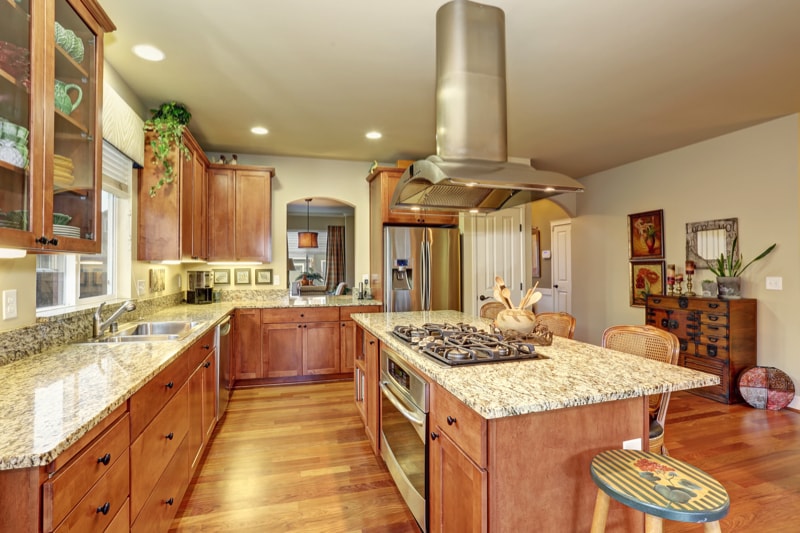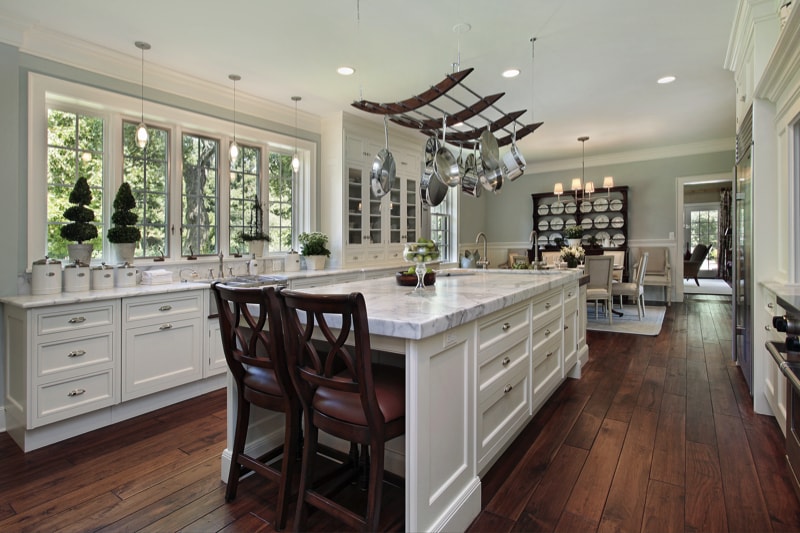
Page Topics
Kitchen Design Ideas & Project Planning
 As with any new kitchen design ideas, an important part of the process is planning out your proposed kitchen designs.
As with any new kitchen design ideas, an important part of the process is planning out your proposed kitchen designs.
This is imperative when you make a decision to either remodel your kitchen or design a new kitchen in a new house build.
Either way, (and as in most things in life) taking some time to plan everything out beforehand will result in a better-finished result.
There will be fewer hiccups along the way and also fewer unexpected pitfalls.
What To Plan For In Your New Kitchen?
One of the first things that you should consider during the kitchen design ideas planning stage is whether your kitchen will include a ‘dine in’ section, like a breakfast bar, or a space for a dining room table.
Or will you choose to have the ‘dining area’ completely separate in a stand-alone dining room?
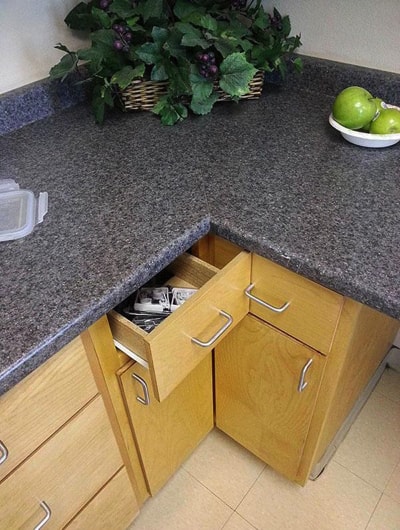
Another important thing to look at is the structure of the space you are considering putting your new kitchen into. Is there any structural limitation or physical challenge that is likely to impact on the kitchen designs?
For example, are there specific wall, ceiling or floor structures, like supporting columns, or sloping ceilings that may get in the way or impede the overall design?
Also ensure you know the location of drainage pipes, the water supply pipes, and whether electricity access could be difficult.
One other essential kitchen design consideration is how often you like to entertain. Decide whether that is important to you and whether you need to factor that in.
If you do like to entertain regularly, you should include this into your design and space requirements.
If, on the other hand, you only entertain guests spasmodically, you may decide to forego the additional space needs.
Either way, this should be well thought out beforehand.
Style preferences will need to be taken into account initially during the planning phase as well.
Your style preferences will likely have quite an impact on your choice of material finishes, the architectural style, the colors, your appliance choices as well as many other aspects of the overall kitchen look.
 Also, will you need to compromise on what you personally want because you’re also creating this kitchen with a partner or a spouse?
Also, will you need to compromise on what you personally want because you’re also creating this kitchen with a partner or a spouse?
There may be other people involved that have their own preferences, likes, and dislikes that need to be taken into account.
Occasionally, partner or spouse disputes or disagreements can cause kitchen project delays, or worse become a complete nightmare for all concerned (especially the poor contractor, or kitchen installers).
That is why it is far better to address as many of these issues beforehand and get clear agreement from your spouse or partner before you launch headfirst into the project.
Other Key Kitchen Planning Considerations
Some other important key considerations to take into account during the planning process, that you may not have thought about, include;
- Are there any Local Government requirements, regulations, or permits to be applied for before you commence work? (And do you have to supply plans, and submit an application fee beforehand?) Check with your Local Government office first, before you even get into the planning stage. The last thing you want is to get so far down the planning stage, only to find there is a holdup, or a roadblock standing in your way before you even start.
- Whether or not you wish to retain any of your existing kitchen appliances? (This is only a consideration when you are remodeling an old kitchen)
- Whether or not there are features of your old kitchen that you really loved and want to retain into the remodeled kitchen.
- What preferences do you have when it comes to kitchen cabinet styling, including features you want or need within your cabinets or drawers?
- Whether or not you would like custom built cabinets or perhaps semi-custom made cabinets? Perhaps you’re the DIY type and would consider DIY kitchen cabinets. These all come at a price, and so budgetary considerations also become an important aspect. We discuss your kitchen budget a little later.
- What type of countertop would you like? There are many options and finishes when it comes to the countertop you could choose. Again this comes down to preferences and budget.
- What timeframe do you have for completing the project? Are you on a deadline, or do you have plenty of time up your sleeve in which to finish the whole project?
- Finally, the big question. How much is your budget going to be for the whole project? There are many hidden costs involved in undertaking a new kitchen project or a kitchen remodeling project. As best as possible, these anticipated costs need to be broken down into their respective components. Then you should add in a percentage over and above that to cover unpredicted contingency incidentals.
Establishing Your Kitchen Budget
Hmmn, the classic $64,000 question. (or is that the $64 question?)
According to Time.com/Money, you should base your investment in your new kitchen according to the value of your house. Their guideline suggests that you should spend between 10% to 15% of your house’s total value on a new kitchen.
 Therefore, depending on what your house may be worth, (not your house and land, but just your house) this is their guide on a kitchen or kitchen renovation budget for a:
Therefore, depending on what your house may be worth, (not your house and land, but just your house) this is their guide on a kitchen or kitchen renovation budget for a:
$300,000 house: Spend between $30,000 to $45,000
$500,000 house: Spend between $50,000 to $75,000
$750,000 house: Spend between $75,000 to $112,500
So whilst the above recommends what you should spend on your kitchen based on the home’s value, this doesn’t necessarily reflect what is actually affordable to you.
Everyone has their own affordability level and so you need to temper these suggestions based on your own financial ability and affordability.
Combined with the above guidelines, the following should also give you some idea as to what you’ll really get for your money, and is another tool in helping to determine your overall kitchen budget:
-
Cheap (Budget Focussed) Kitchen Design
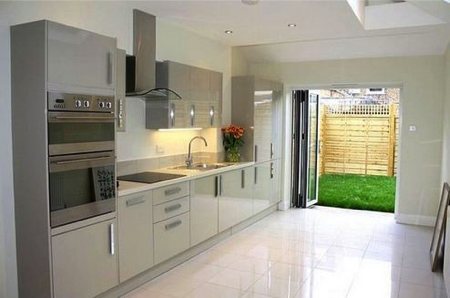 You can expect to pay between $5,000 and $30,000. This is very much the low end, but it is also a segment of the kitchen market that is well catered for and appeals to many people.
You can expect to pay between $5,000 and $30,000. This is very much the low end, but it is also a segment of the kitchen market that is well catered for and appeals to many people.
You may choose to do a lot of the work yourself, enabling you to spread your budget dollar even further.
That will save on a lot of labor cost, however if you decide to go through a kitchen designer and have the kitchen installed by a contractor, you can expect to budget a lot more, perhaps between $20,000 and $25,000 (and maybe even up to $30,000)
-
Good Quality Mid Range Kitchen Design
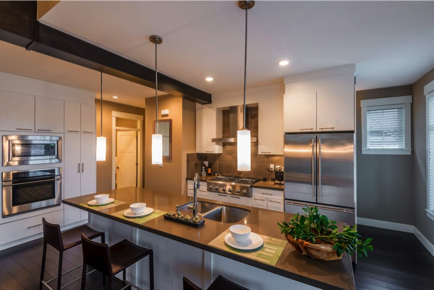 A kitchen in the midrange is going to set you back something in the vicinity of $30,000 to $70,000.
A kitchen in the midrange is going to set you back something in the vicinity of $30,000 to $70,000.
This level of a budget will get you a very nice kitchen (and you won’t need to do much or any of the work yourself.)
There are quite a number of options open to you when you are looking to spend in this range.
Some compromises may be necessary, but on a whole, the further up that scale you are, the better quality kitchen you’ll get.
According to Cost vs. Value by Remodeling.com, the average mid-range kitchen renovation is around $56,768.
-
Luxury Kitchen Design
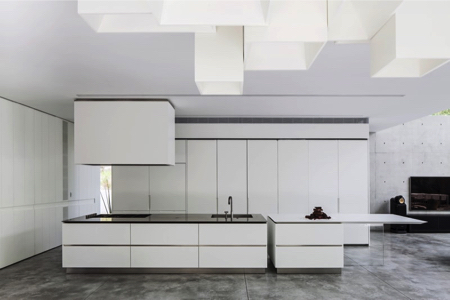 With top end luxury kitchens, there really is no limit to what you can spend your money on.
With top end luxury kitchens, there really is no limit to what you can spend your money on.
If your budget is only limited by your imagination, then the sky really is the limit.
Luxury finishes, luxury top end branded appliances, exquisite lighting, designer taps, Imported countertops, and flooring can all be tailor-made or sourced to meet your own tastes or desires.
A high-end kitchen will cost you anywhere upwards of $75,000 with many extending well into six figures.
According to Cost vs. Value by Remodeling.com, the average top end kitchen renovation is around $113,097
What Is Your Budget?
Setting a budget for a kitchen build or makeover can be based on several situations.
The following scenarios are examples of what could have a big influence on what you’re prepared to spend or budget for the kitchen do up, or new kitchen build and include;
- You want a nice looking kitchen that will appeal to house buyers because you’re intending on selling the house in the next 3- 6 months. You want to spend well so that it looks the part without spending a fortune.
- You want a hardwearing kitchen that will stand up to a lot of ‘abuse’ but still look good because you plan on renting the house out on a long-term basis. Therefore, you want to spend as little as possible, but you still want the best quality that your money will afford.
- This is your dream kitchen. It’s the one you’ve been waiting all your life to build. It is going to sit in your dream home, the house you intend to see the rest of your living days out in. You want to pamper yourself with the very best you can afford in all areas of the kitchen. Potentially you may be limited on how much you have available to spend, but you want the finest your money can buy.
- Perhaps this is your holiday house or apartment, and you spend very little time there during the year, but you just want a practical, and functional kitchen that will meet these functional needs.
- Maybe this is your dream kitchen, but you’ve actually had to scrimp and save over the years to finally get to the stage where you have enough funds to invest in a much-needed new kitchen in your home. Money’s tight, (but when isn’t it?) but you and your family deserve a decent modern kitchen. You want the best you can afford, and of the highest quality possible, and potentially on a strict budget.
 All of these examples are everyday scenarios for many people from all walks of life.
All of these examples are everyday scenarios for many people from all walks of life.
Whatever situation you find yourself in, your situation will probably be just as unique. Perhaps we could have even included your own scenario in one of these above examples.
The point is, whether its just you, or you and your spouse, or partner, that are making these decisions, the overall kitchen budget is probably the biggest preliminary decision you will have to make.
And whilst, there is no ‘one size fits all’ situation, please do take some time to really go over each area where you are likely to spend reasonable amounts during your kitchen build.
In the initial stages when you’re trying to quantify how much you’re going to need, or how much you can afford, you may need to do a little market research by searching online for various costings.
Better still, go and visit some of the local kitchen builders, manufacturers, and installation companies to get a gut feeling of what you’ll get for your money.
Armed with this sort of valuable knowledge, you’ll be better positioned to sit down with your spouse, or partner (or by yourself) and go over these items, and then assign rough estimates of how much you think you might need to spend.
We’ve listed below some of the key areas that will absorb most of your kitchens budget;
The Main Areas Where You’ll Spend Your Kitchen Budget
- Kitchen cabinets (Kitchen Islands, Yes, or No?)
- Kitchen countertops
- Kitchen sinks
- Appliances (Don’t forget to factor in professional labor for installation if you aren’t able to do these yourself)
- Refrigerator
- Range hood
- Oven
- Cooking Hob
- Sink Waste master
- Kitchen Flooring
- Kitchen Lighting
- Kitchen Splashback
- Electrician Costs (Power points, how many, and where?)
- Plumbing and Drainage Costs
It may pay to also keep in mind that there is an old saying (that is true in many cases) and that’s to “add 50% to your initial estimate!”
If you have a budget in mind for your own project, it can often be a good idea to scale this back somewhat to allow for some contingency costs from the unexpected or the unpredictable.
Understanding Kitchen Costs
All kitchen renovations, new builds, or remodels cost money, and there are so many areas within a kitchen build where you can literally spend a fortune.
How Should You Divide Up Your Budget?
 According to The National Kitchen & Bath Association (NKBA) their percentage breakdown of kitchen remodelling costs by area suggests following the formula in the table below.
According to The National Kitchen & Bath Association (NKBA) their percentage breakdown of kitchen remodelling costs by area suggests following the formula in the table below.
Once you’ve established your own ‘Affordable Budget’, this is roughly how you should plan on breaking it down into the specific areas.
This can then help you determine the affordability (or not) of some of those dream fittings or features you desire.
This isn’t necessarily a hard and fast rule, but as a guide, it might direct you to ‘rob Peter to pay Paul’ within your budget, particularly if certain aspects of your kitchen build don’t fit within the following percentage guides, and yet are still a ‘must have’ for you.
| · Cabinetry & Hardware | 29% |
| · Installation | 17% |
| · Appliances & Ventilation | 14% |
| · Countertops | 10% |
| · Flooring | 7% |
| · Walls & Ceilings | 5% |
| · Lighting | 5% |
| · Design Fees | 4% |
| · Doors & Windows | 4% |
| · Faucets & Plumbing | 4% |
| · Miscellaneous | 1% |
Ultimately though, your kitchen will be a reflection of your family and your lifestyle, and you are the best person to apportion the budget according to what is most important to you.
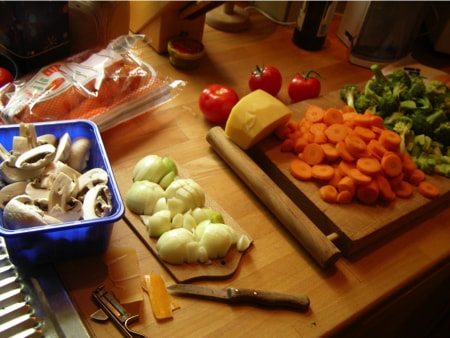 If you’re a passionate cook, or chef, then perhaps the appliances may be the most important area for you to spend your money on.
If you’re a passionate cook, or chef, then perhaps the appliances may be the most important area for you to spend your money on.
If on the other hand, you’re an avid entertainer, then you’ll be thinking wine coolers, and warming drawers, whereas if you’re just an everyday family, then perhaps you’ll be looking to maximize the storage space wherever you can.
Unless you’re really very young, chances are, you’ve lived and worked in many a kitchen during your life.
Think about what you like, and dislike, maybe even jot down a note or two that you can keep handy for when you start shopping around.
The best advice about where to spend your money is to put it where it will deliver the most value and get the best use for you and your family.
A Staged Development Process?
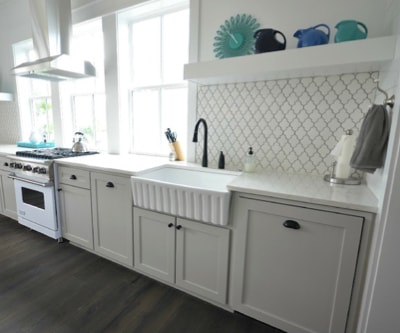 Another thing you might want to consider when contemplating what’s important in your kitchen is to think about it as a ‘staged development’.
Another thing you might want to consider when contemplating what’s important in your kitchen is to think about it as a ‘staged development’.
A kitchen is likely to have a minimum life of 10 years (assuming you choose well) and if you feel controlled initially by your budget as to what you can afford in certain areas, perhaps splurge out initially on the bigger things that would be difficult to change later on.
Then, a few years later, perhaps when you have more budget available to you, you can change the less expensive items that are easier to change that you compromised on initially.
In effect, this is suggesting to spend less initially on the things that can be easily changed later. Here are a few examples, to give you some idea;
- Compromise on your wall tiles, but invest mostly in your countertop. It’s really hard to replace a countertop once it’s in place.
- Be very conservative on cabinet frames, and invest more into cabinet doors and hardware. Let’s face it, the cabinet frames get very little use, so why invest heavily there? It makes no sense to.
- Save on your kitchen tapware and instead invest into a decent sink. Whilst its true the tap will get a lot of use, it can be easily changed at some other point in the future, whereas a sink is much more difficult (and expensive) to change.
- Think about installing a composite or laminate look countertop that will cost you probably half the cost of the genuine solid type and will look equally as good. Most people won’t be able to tell the difference anyway. That leaves a lot of budget to spend elsewhere.
Designing Your Kitchen
When you get to the kitchen designing stage, there are a number of points to consider. (Yes, I know, more things to take into account)
Kitchen’s are created with a number of different factors in mind when it comes to the design.
Firstly, What Size Of Kitchen Do You Want?
Just how big do you want this kitchen to be? Or more so, what is the maximum size its capable of being, given perhaps limitation of space?
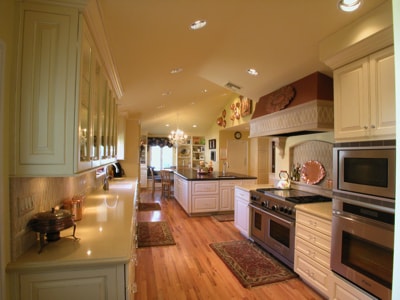 It may be a very hard question to answer if you don’t have the experience or expertise but think about the number of people who are likely to be cooking in it.
It may be a very hard question to answer if you don’t have the experience or expertise but think about the number of people who are likely to be cooking in it.
If it’s a real family affair and there’s often two or three people in there at any one time, then go for the larger size.
If on the other hand, it’s a kitchen for either a single person or a couple, then the smaller sizes may suffice.
Needless to say, the last thing you want is for an older couple with no children left at home to be rattling around in a super large kitchen area.
It just doesn’t make sense. As they often say, its horses for courses.
Therefore, if you are a couple and you’re comfortable in a small kitchen, that’s fine if you don’t ever contemplate selling. However, you may want to consider (when planning a kitchen remodel) making it just a little bigger in case you ever do decide to put your house on the market and you want to have maximum appeal to both couples as well as small families.
Small kitchens can put these types of house buyers off.
The average kitchen size these days is definitely much bigger than it was in previous generations, and it’s not uncommon nowadays to have kitchens defined by the National Kitchen and Bathroom Association as small, medium, or large based on the following square footage.
- 70 square feet or less defines a small kitchen.
- 100 square feet would be considered average, especially given that a 10 ft x 10 ft kitchen is used as a standard benchmark for estimating kitchen remodeling costs.
- 175 – 200 square feet is considered medium and may or may not include an adjoining dining area, and
- 225 square feet or more is considered on the large side.
Another point to take into account when determining the size of your kitchen is how many kitchen appliances you have.
And are you the type of person who prefers them on the countertops ready to use, or neatly stored away out of sight?
What Is Your Preferred Kitchen Layout Style And Shape?

Besides the kitchen size, the next consideration is the preferred layout configuration.
As a general rule, these days, an open plan concept is preferred whereby the living room space, dining area, and kitchen are all contained within one large room.
Some people, however, may still prefer to have the kitchen in its own unique ‘closed off’ area, or perhaps even a hybrid where it is a semi-open plan.
Whatever preference in terms of either closed or open, a very important decision now needs to be made as to your overall preference of actual kitchen shape layout.
In many ways, your kitchen dimensions, or the fundamental room layout may not give much choice around this, but if you do have the flexibility, then this is where you will decide on the kitchen shape to go with. These will be either;
- L-shaped kitchen (with or without a kitchen island bench),
- U-shaped kitchen (with or without a kitchen island bench),
- Single-line kitchen (where your cabinets are all along a single wall) – often combined with an island bench
- Galley shaped, (two sets of cabinets, usually along two parallel walls)
- Custom shaped kitchen (to fit an unusual floor layout or space)
Once you have determined your kitchen shape, you now need to decide upon is the look.
Do you prefer the ‘Traditional look’, the ‘Contemporary’ (modern) look, or the ‘Casual’ (relaxed) look?
Your decisions on these points will have a significant bearing on much of your overall kitchen design, and the decision will also again be dependent on your own situation, for example, you may love the traditional look, but that may not be practical for a rental or a holiday home.
Important Considerations During The Kitchen Designing Stage
The Working Triangle
An important structure for the kitchen is the working triangle. This is the (imaginary) lines that connect the stove, the sink, and the refrigerator and the points connecting all three.
This is usually (or should be) shaped like a triangle. These are the most used areas in the kitchen, with the sink probably receiving the majority of use.
When planning where to place things within your kitchen, try and take into account where your plumbing and waste pipes are situated, and if they are not conveniently located, consider hiring a plumber to relocate the pipes to where connection to the sink will be easier and convenient, enabling you to make full use of the sink, and then structure your working triangle accordingly.
When adding up the length of all of the three legs of this triangle, try and keep the total length to between ten and twenty feet to prevent people from tripping over one and other, and likewise, don’t make it greater than twenty-five feet, otherwise, the whole workspace will become impracticable.
Don’t Waste Kitchen Storage Space
 Almost every kitchen will have some element of waste storage space, but the key here is to minimize any unusable space as much as possible through careful planning and thinking ahead.
Almost every kitchen will have some element of waste storage space, but the key here is to minimize any unusable space as much as possible through careful planning and thinking ahead.
If you have limited space in your kitchen generally, then consider installing additional cabinets on the higher parts of the wall, and always make sure there is storage above the refrigerator.
Take a look at a few kitchens in kitchen display shops, or online magazines, and get a few ideas on how they manage to achieve maximum storage space.
You’re bound to find a few interesting and innovative ideas where adventurous kitchen designers have created innovative methods to turn some of the wasted space into practical storage.
Integrate these ideas into your own design where you can.
Maximize Kitchen Countertop Space
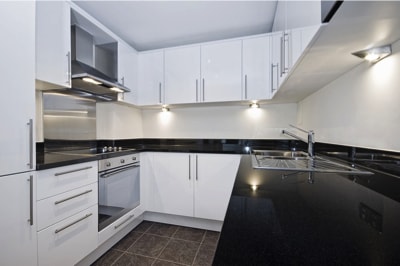 A common complaint with a lot of kitchen designs is that they lack a countertop bench or working space. Always make sure that you allow for sufficient horizontal working and preparation bench space.
A common complaint with a lot of kitchen designs is that they lack a countertop bench or working space. Always make sure that you allow for sufficient horizontal working and preparation bench space.
Also, depending on whether you like to have various appliances permanently on display ‘at the ready’, you might want to consider allowing for some additional countertop to accommodate them.
Kitchen Islands can be a great way to add considerable working countertop space as well as additional drawer storage space.
Provide Adequate Kitchen Lighting Ideas
Be careful with lighting in your kitchen. You need to provide enough lighting to make the working areas safe. There are three types of kitchen lighting that you need to allow for;
- task lighting,
- accent lighting and
- overall illumination.
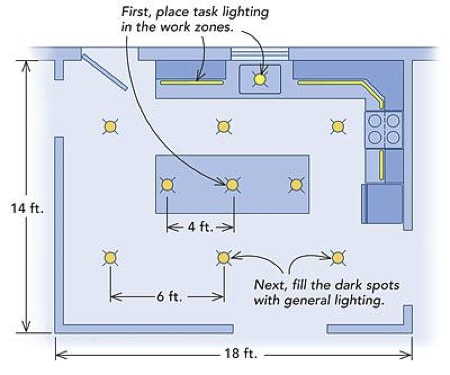
Task lighting is important to enable adequate vision during the preparation and cooking processes.
Natural or artificial illumination will not suffice for task lighting which needs to directed over the working spaces.
Accent lighting is what will provide the ‘Wow’ factor to many aspects of your kitchen. Examples being, pendant lights over a kitchen island, a breakfast bar or a sink area.
These look great and will highlight your overall kitchen design.
There is some thought that natural lighting through windows should be maximized into the kitchen, so if you have a tiny kitchen window and no other means of natural lighting, you could choose to invest well in the overall kitchen illumination lighting, or perhaps consider (if there is ample wall space) having a wider kitchen window installed to increase the natural light.
When it comes to night time, there still needs to be adequate overall illumination in the kitchen as well as sufficient task lighting over each of the key workspaces.
Invest In A Kitchen Backsplash
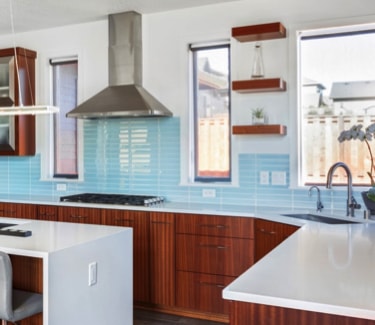 Some people decide as a means of saving a few extra dollars on their kitchen budget, that they will forgo a backsplash above their cooktop and counters. We believe you should rethink this.
Some people decide as a means of saving a few extra dollars on their kitchen budget, that they will forgo a backsplash above their cooktop and counters. We believe you should rethink this.
A kitchen (particularly above cooktops) will have a lot of steam, fat, and grease splatter that in the absence of a backsplash (paint or wallpaper) will look terrible and become difficult to clean off.
An easily cleaned backsplash will keep that area looking pristine and will help you to maintain the good looks of your kitchen. Its far better and easier to clean when there is a backsplash installed made from either tiles, metal, or colored glass rather than have to repaint, or re-wallpaper over a greasy, moist moldy looking wall.
Don’t Ignore Poor Kitchen Ventilation
With poor ventilation to a kitchen, offensive odors can linger for days. Installing cheap range hoods may not cut it either, they tend to just recirculate the stale, or dirty air, whereas a good kitchen ventilation system can make a significant difference to the kitchen’s air quality and also helping to keep it clean and smell free.
The more ‘open plan’ your kitchen is, the more important this aspect becomes.
Don’t Choose The Wrong Kitchen Island
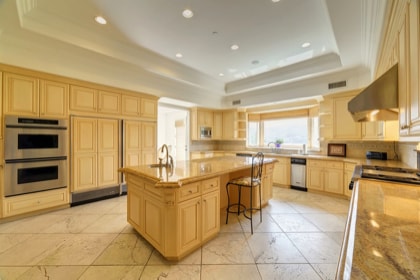 It’s a common belief amongst kitchen specialists that before you contemplate including a kitchen island in your design, that your kitchen needs to be at least 12 feet long and 8 feet deep.
It’s a common belief amongst kitchen specialists that before you contemplate including a kitchen island in your design, that your kitchen needs to be at least 12 feet long and 8 feet deep.
The problem with installing a kitchen island is that they can obstruct the workflow, and create working bottlenecks if placed incorrectly or are too big for their space.
Installing an island in your kitchen can be a great functional feature, but it needs to be taken seriously with a detailed analysis of foot traffic flow and the availability of space within the kitchen.
If it can be installed so that it provides an additional countertop workspace, whilst not hindering floor workspace in and around the sink, refrigerator, stove or other key workspaces, then it’s all good to go. If not, then think of doing without one.
Go Easy On The Latest Trendy Styles
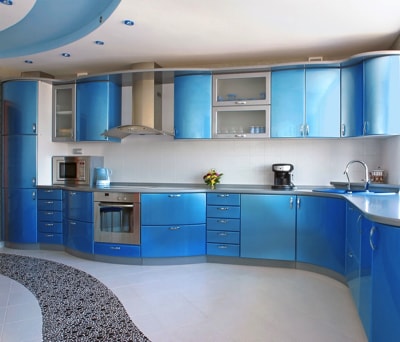 Many people get ‘Wowed’ into the latest and coolest kitchen colors, styles and designs.
Many people get ‘Wowed’ into the latest and coolest kitchen colors, styles and designs.
Whilst this isn’t necessarily wrong, you need to very aware that these will date and go out of favor just as quickly as they came in.
Trends and fads come and go, and it’s not uncommon to see half a dozen different fads or trend ideas come and go during the normal lifetime of a kitchen.
In many ways, it pays to stick to the ‘dateless’ colors, styles and appliances. That way when you come to sell your home in ten years time, people won’t be put off by your ‘old, tired, and dated’ kitchen.
Consider Using a Professional Kitchen Designer
Kitchen Designers are trained in providing the best solution for your budget. They will take time to understand your needs and wants and will translate that all into a design and plan that will match your tastes and your budget.
They will also in most instances be able to prepare a CAD (Computer Aided Design) image of your proposed kitchen design. You can expect them to charge fees in the range of $50 to $150 per hour, or approximately 5% to 15% of the total project value.
Opting to design and manage the project yourself from start to finish may save a few dollars up front, but unless you’re experienced at designing a kitchen and its development, it will likely cost you much more in the long run. Always remember the old adage, “A little knowledge can be a dangerous thing”.
Kitchen Remodeling Tips and Advice
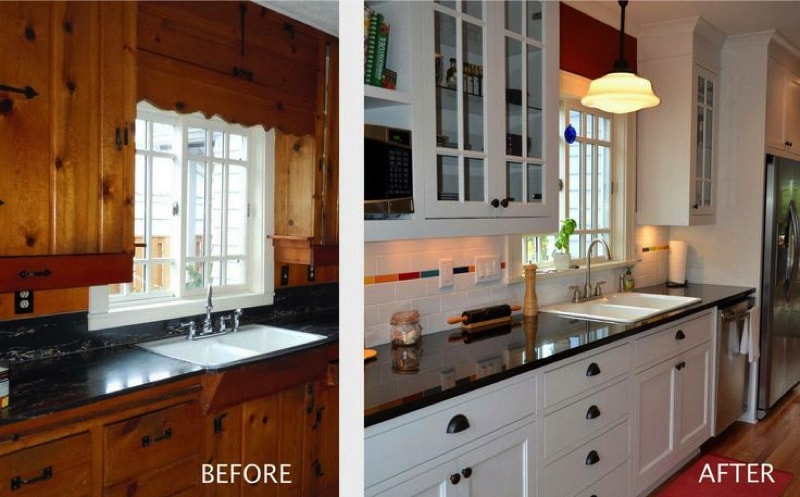
Most of the previous tips and guides previously discussed apply, whether you’re building a new kitchen from scratch, or whether you’re remodeling an older kitchen. The only real differences are the extent to which you decide to invest in your new kitchen.
In other words, whether you decide to just do a quick makeover with a bit of paint and paper, or whether you decide to go a lot further, like replacing cabinet door fronts, replacing the backsplash, replacing the countertops, or upgrading the lighting and flooring and appliances.
When it comes to kitchen remodeling, there will be lots of variations from one project to the next, so here are some fundamental tips on how to get the best result and the most out of your budget, whatever that might be.
- Try and stay within your existing floor footprint, unless you have access to adjoining cupboard space or some other adjoining unused space. Adding floor area to your kitchen may sound a nice idea in concept, but the reality is, it will add significantly to your overall costs. If your floor area has been sufficient for your family requirements up to this point, then there should be no need to extend it and add to the overall costs.
- Plan to invest most of your funds into good quality cabinets and flooring. The cabinet doors and drawers are always going to receive the most useful and so, therefore, don’t scrimp on investing in good quality hinges and sliders. Buy the best you can afford and go for well-reputed brands, not some bargain cheap import.
- Preferably go for a good quality floor tile, or even a natural ‘sealed’ stone rather than hardwood flooring. They will last the distance, be easier to clean and retain the look over a longer period.
- Be wary when it comes to purchasing new appliances. Whether you spend $10,000 or $500 on a new stove, it still probably won’t heat your food any quicker. Sure, they may be made from better, more durable materials and parts, but you need to weigh up in your own mind whether such an investment is worth it to you. For an expensive kitchen remodel, obviously, you’ll look for expensive appliances to fill it, whereas if you’re more budget focused, look around for ‘sell off’ items, ‘stock surplus’ sales, and the like for bargains. There are plenty to be had if you shop around. You shouldn’t have to pay retail prices for good appliances.
- If it’s within your budget, and affordable, look to gut your existing kitchen and start from fresh. That way, you can re-wire, re-plumb, and re-level the floors and identify any potential problems that might otherwise cause problems down the track.
- If you’re inclined and are handy with a hammer, a paintbrush or a screwdriver, do as much of the work as you can to reduce overheads.
- When it comes to lighting, if you have the ability, or the wherewithal to add or enlarge a window, then it will be worth it. If not, then ensure you include all the ambient lighting you can. Consider recessed lights, and don’t scrimp on task lighting over key work areas.
Hiring the Right Kitchen Contractor
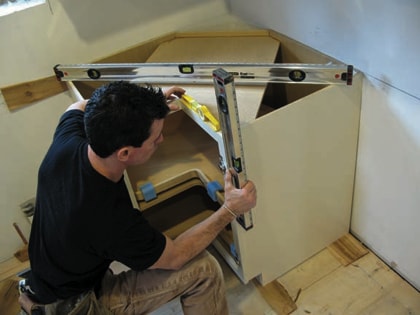
Now that you have a good idea on your layout, your plan, your style and other key aspects of your new kitchen, now is the time to get some bids or quotes from professional kitchen contractors or installers.
Ask them to itemize each component of their work to enable you to better compare the various quotes, and always try and get about four or five bids.
Be very wary of the cheapest and the most expensive and if you notice significant variations in pricing around a specific item, then you may need to clarify with them that they understood your requirements correctly.
High priced bids that are above the average of the others possibly indicates a contractor who is too busy to do your project and for some reason doesn’t really want the job, so they price it at a level where they don’t expect to get the job.
Don’t try and screw a contractor down on their labor rate. If their original bid seems reasonable to you and they check out in all other areas, (reviews, testimonials, etc) then just accept their bid.
You don’t want a contractor to feel like they’ve been squeezed on price, otherwise, they’re likely to look for shortcuts to cover their losses.
Ask your local kitchen and hardware retailers for a list of approved or recommended contractors. They won’t usually recommend anyone that does a shoddy job as it will reflect back on them.
Ask the Contractor about their insurances (and get proof). They should, as a minimum have personal liability and property damage cover.
Also, check out their history on the BBB (Better Business Bureau)
Find out about local licensing requirements (they vary by state and municipality) and always ask to see the contractor’s license and make sure it’s current.
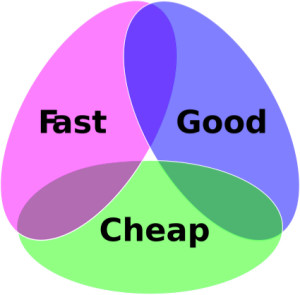
Finally, when you are close to deciding and have narrowed down your options, ask the Contractor for recent references and testimonials and make sure you contact them and get honest feedback.
Do some local research on Google for their business name and see if you can get a balanced viewpoint.
Not every Contractor will keep everyone happy all of the time, so its likely that there will be one or two adverse reviews or feedbacks as well as all the glowing ones they gave you.
If you do find some, make your own judgment call by reading through the issues. Sometimes, this won’t even be relevant to your situation, so don’t be too quick to judge.
View the Next Guide In The ‘New Kitchen’ Series by Clicking on the link below
Buying Buying Home Kitchen Appliances For Your New Kitchen
